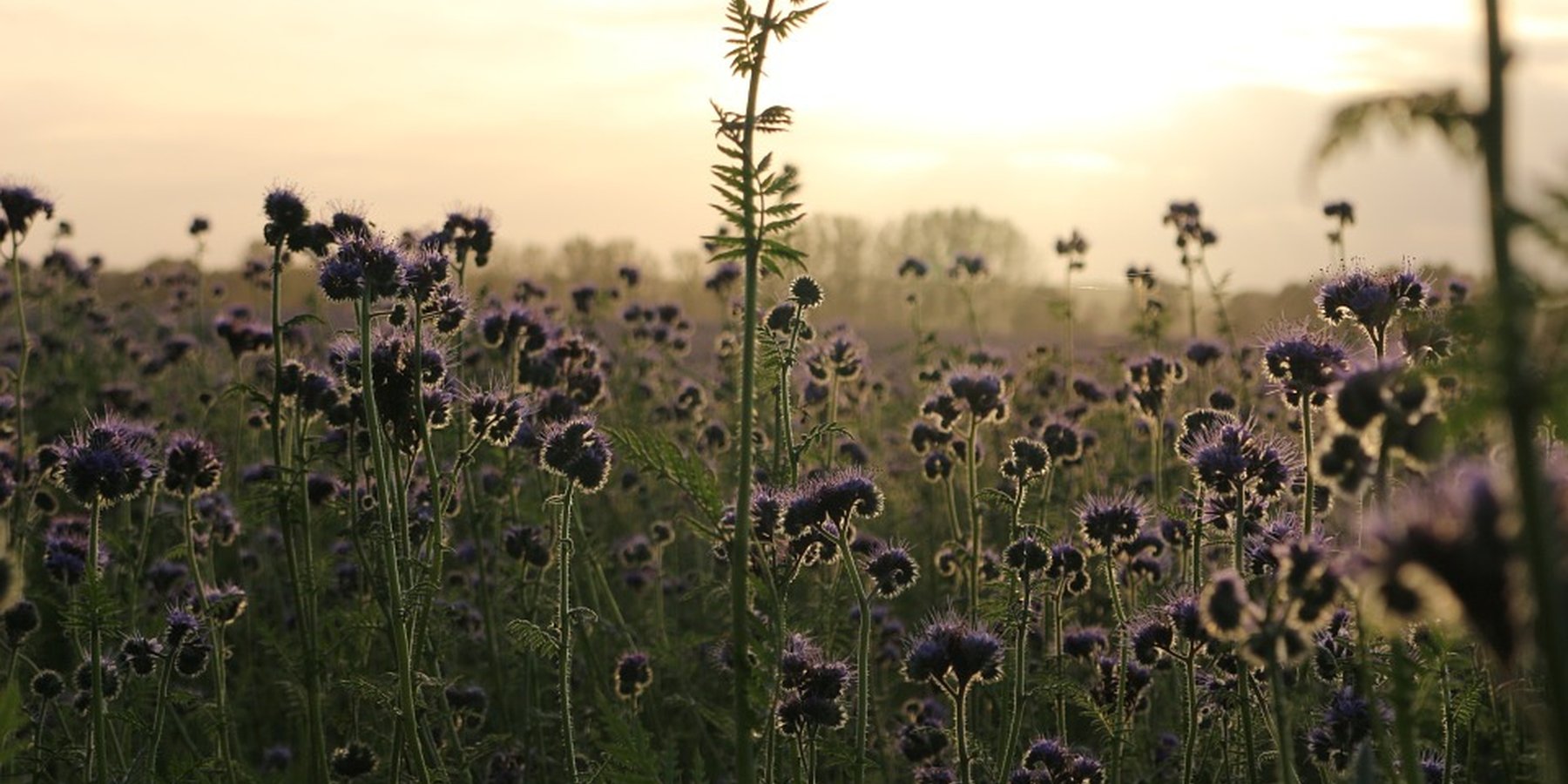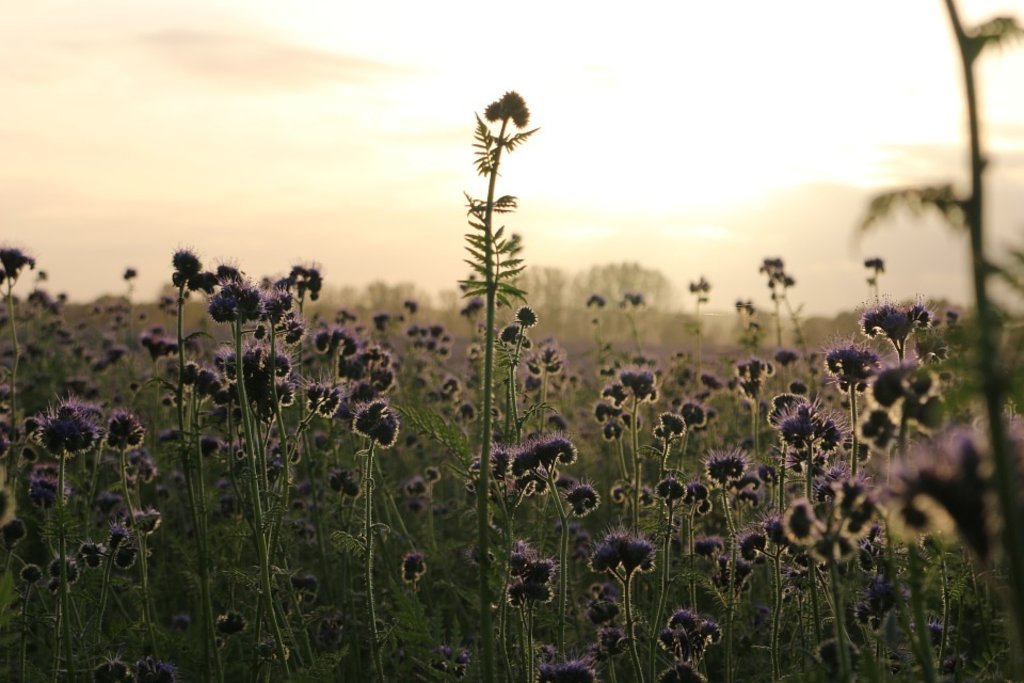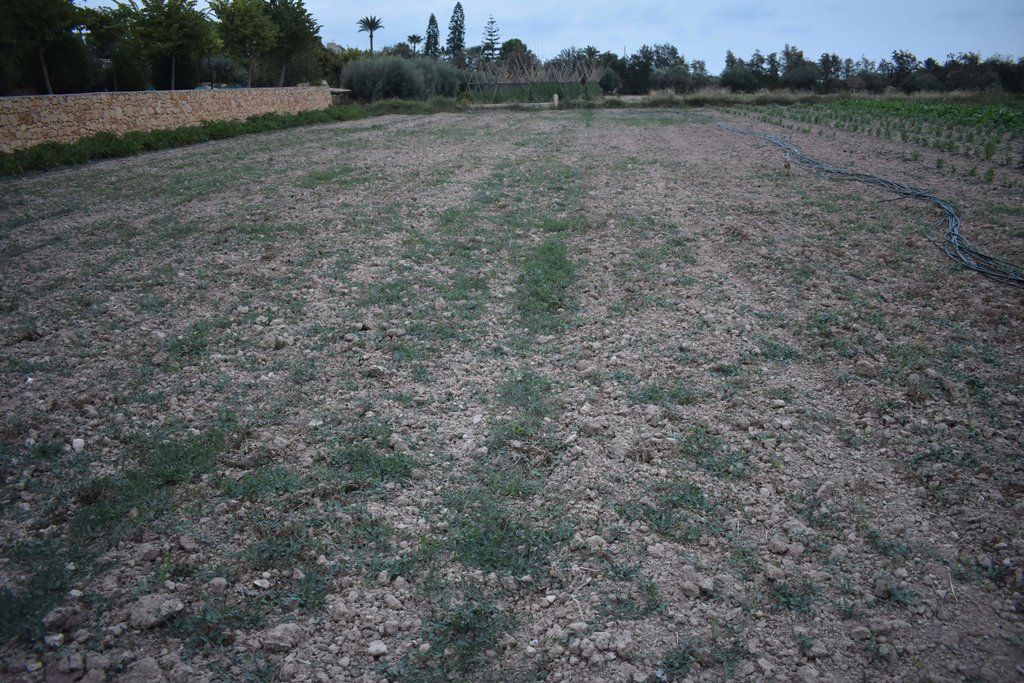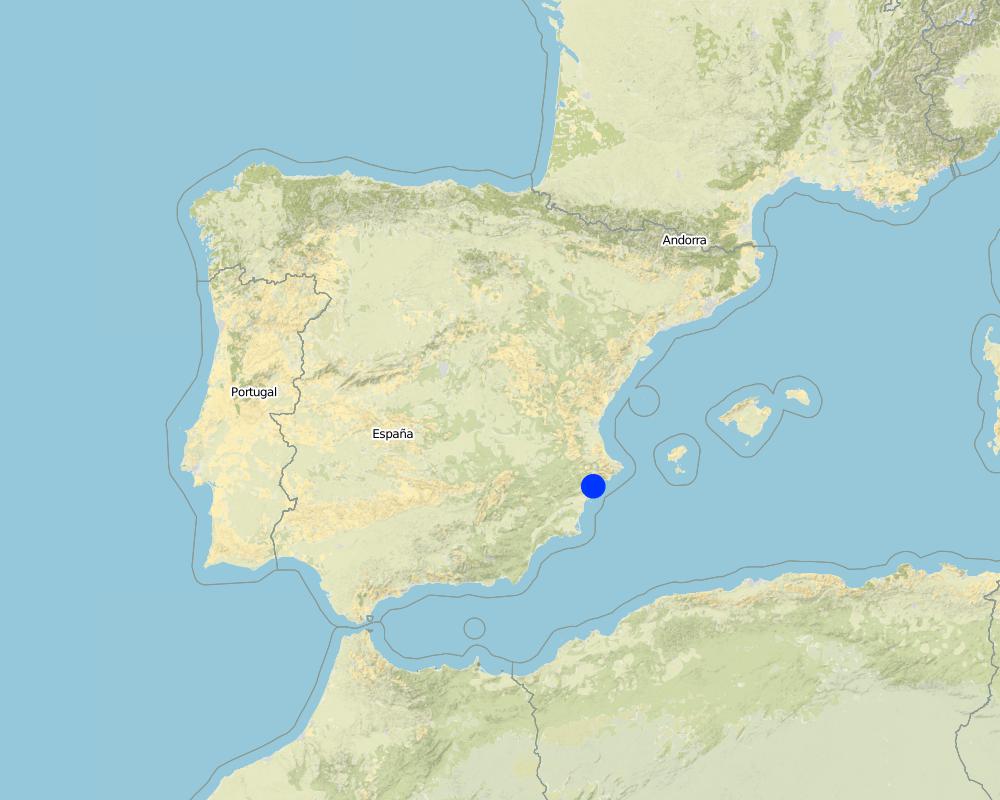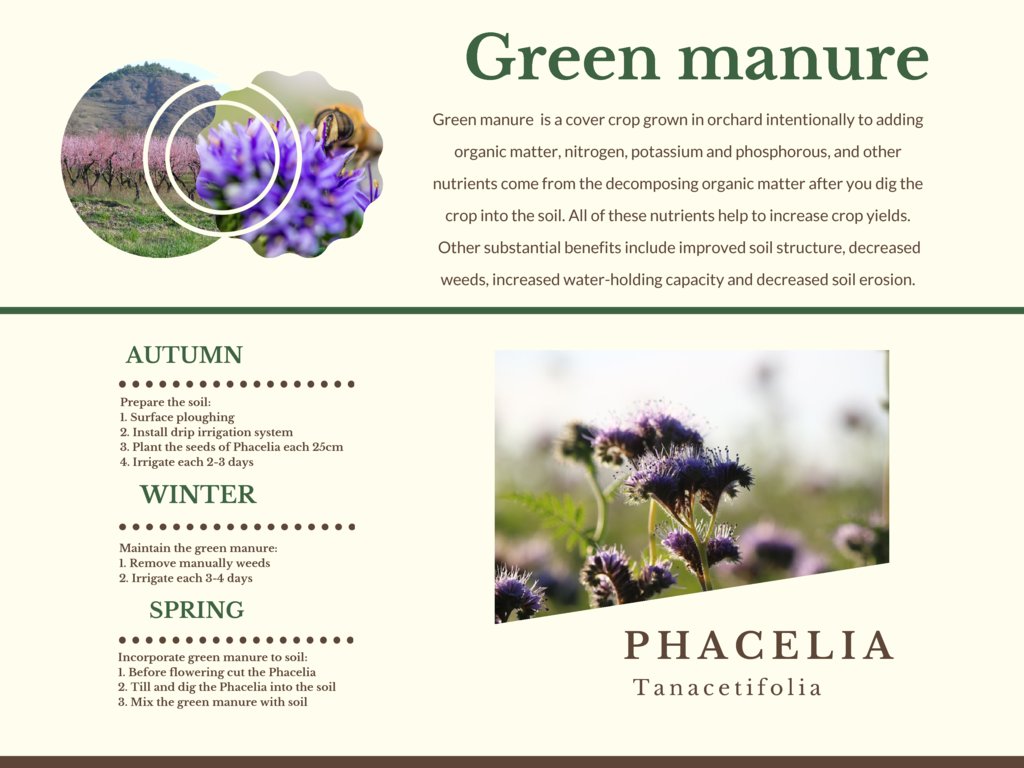Annual green manure with Phacelia tanacetifolia in southern Spain [Espagne]
- Création :
- Mise à jour :
- Compilateur : Alicia Morugán-Coronado
- Rédacteur : –
- Examinateurs : Ursula Gaemperli, Alexandra Gavilano
Abono verde con Facelia
technologies_3219 - Espagne
Voir les sections
Développer tout Réduire tout1. Informations générales
1.2 Coordonnées des personnes-ressources et des institutions impliquées dans l'évaluation et la documentation de la Technologie
Nom du projet qui a facilité la documentation/ l'évaluation de la Technologie (si pertinent)
Interactive Soil Quality assessment in Europe and China for Agricultural productivity and Environmental Resilience (EU-iSQAPER)Nom du ou des institutions qui ont facilité la documentation/ l'évaluation de la Technologie (si pertinent)
Agrochesmistry and Environment Department, University Miguel Hernandez (UMH) - Espagne1.3 Conditions relatives à l'utilisation par WOCAT des données documentées
Le compilateur et la(les) personne(s) ressource(s) acceptent les conditions relatives à l'utilisation par WOCAT des données documentées:
Oui
1.4 Déclaration sur la durabilité de la Technologie décrite
Est-ce que la Technologie décrite ici pose problème par rapport à la dégradation des terres, de telle sorte qu'elle ne peut pas être déclarée comme étant une technologie de gestion durable des terres?
Non
2. Description de la Technologie de GDT
2.1 Courte description de la Technologie
Définition de la Technologie:
Application of annual green manure with Phacelia Tanacetifolia sp. to improve soil quality and productivity on agricultural land.
2.2 Description détaillée de la Technologie
Description:
1. This sustainable land management technology was established on agricultural land in Mutxamel (region of Alicante) in the municipality of Valencia (Comunidad Valenciana), Spain. Agricultural production in this region is of a very high quality and is intensely competitive. Despite this, the region’s traditional agriculture industry is nonetheless being overtaken by other sectors, with the scarcity of water emerging as a key factor in this shift. The main orchards in this region are: citrus, lemon, almonds and olives trees, other common crops are vegetables, such as tomatoes, lettuce, etc.
2. The SLM technology focuses on annual cultivation of green manure in the form of the plant of Phacelia tanacetifolia. Phacelia tanacetifolia (Hydrophyllaceae) is commonly known as Lacy or Tancy Phacelia (syn. Purple Tancy, Fiddleneck and Valley Velvenia). Native to Californian drylands, chaparral and Central oak woodland, P. tanacetifolia has been naturalised throughout the western United States and frequently in Europe, whereas it has been extensively used as a nectar crop up and as annual green manure worldwide. Phacelia is listed as one of the top 20 honey-producing flowers for honeybees and is very rich in both nectar and pollen the lavender-coloured flowers attract bees, butterflies and other pollinating insects.
3. Initially, the main objective of the land user applying the technology was to improve the soil quality and the crop production in the vegetable fields (cabbages, tomatoes, lettuce, chards, spinach) by cultivating the Phacelia plant as an annual green manure. In other words, the maintenance of a specific cover crop such as Phacelia tanacetifolia grown in the orchard is intended to add organic matter, nitrogen, potassium and phosphorous and other nutrients coming from the decomposed manuring plant after it is worked into the soil.
4. The land user prepares the soil during September or October by ploughing the surface of soil and then sowing the Phacelia tanacetifolia seed thinly at a rate of 1 gram per square meter and within 25 cm per plant. In the examined case, the land user installed a drip irrigation system to irrigate every two to three days in autumn or every three to four days in winter. During winter time it is recommended to remove manually spontaneous plants. Before seed formation (February or March) the land user cuts the plant and then he is tilling and digging the cover crop gently into the soil, in order to incorporate all the nutrients of this green manure into the soil. It is crucial to cut the plant before seed formation; otherwise the nutrient capacity to the soil is reduced.
5. The major benefit of the intercrop of Phacelia tanacetifolia is the short term enhancement of the soil organic content. It keeps the soil more fertile during one year and therefore it has to be cultivated every year. In consequence also an improvement of the orchard productivity has been determined. Other substantial benefits are the stronger N fixation, the decrease in weeds, and the improved water-holding capacity; further to be mentioned, the better soil aggregation, as green manure crops help to improve the soil structure over time, and by this the aeration increases, and water infiltration and root growth are enhanced. Finally, the improved soil cover helps to control the risk of soil erosion.
6. One major disadvantage is the fact that Phacelia is not polyvalent. It is only an annual green manure plant, but unfortunately not also a marketable crop that could create monetary benefits in addition. Other disadvantages mentioned by the land user are the relative high establishment expenses, as for example for the irrigation equipment and as well the maintenance costs.
2.3 Photos de la Technologie
2.5 Pays/ région/ lieux où la Technologie a été appliquée et qui sont couverts par cette évaluation
Pays:
Espagne
Région/ Etat/ Province:
Alicante
Autres spécifications du lieu:
Mutxamel
Spécifiez la diffusion de la Technologie:
- répartie uniformément sur une zone
S'il n'existe pas d'informations exactes sur la superficie, indiquez les limites approximatives de la zone couverte:
- < 0,1 km2 (10 ha)
Map
×2.6 Date de mise en œuvre de la Technologie
Indiquez l'année de mise en œuvre:
2014
2.7 Introduction de la Technologie
Spécifiez comment la Technologie a été introduite: :
- grâce à l'innovation d'exploitants des terres
Commentaires (type de projet, etc.) :
The land user consulted several online sites about different green manure types.
3. Classification de la Technologie de GDT
3.1 Principal(aux) objectif(s) de la Technologie
- améliorer la production
- réduire, prévenir, restaurer les terres dégradées
- préserver l'écosystème
- conserver/ améliorer la biodiversité
3.2 Type(s) actuel(s) d'utilisation des terres, là où la Technologie est appliquée

Terres cultivées
- Cultures annuelles
- Plantations d’arbres ou de buissons
Cultures annuelles - Précisez les cultures:
- légumes - autres
Plantations d'arbres et d'arbustes - Précisez les cultures:
- citron
- olive
- fruits à coque (noix du Brésil, pistaches, noyers de bancoule, amandes)
- lemon
Nombre de période de croissance par an: :
- 1
Précisez:
March
Commentaires:
Main crops (cash and food crops): Phacelia Tanacetifolia as a green manure to prepare the soil to rotation crops: cabbages, tomatoes, lettuce, chards, spinach.
3.3 Est-ce que l’utilisation des terres a changé en raison de la mise en œuvre de la Technologie ?
Est-ce que l’utilisation des terres a changé en raison de la mise en œuvre de la Technologie ?
- Oui (Veuillez remplir les questions ci-après au regard de l’utilisation des terres avant la mise en œuvre de la Technologie)
Les divers types d'utilisation des terres au sein du même unité de terrain: :
Oui
Commentaires:
If land use has changed due to the implementation of the Technology, indicate land use before implementation of the Technology: Grapevine orchard for wine production
3.4 Approvisionnement en eau
Approvisionnement en eau des terres sur lesquelles est appliquée la Technologie:
- pleine irrigation
Commentaires:
1 hour of irrigation during the week in summer period, 2-3 days per week in autumn and spring season and 1 day per week during winter.
3.5 Groupe de GDT auquel appartient la Technologie
- système de rotation (rotation des cultures, jachères, agriculture itinérante)
- Amélioration de la couverture végétale/ du sol
- gestion intégrée de la fertilité des sols
3.6 Mesures de GDT constituant la Technologie

pratiques agronomiques
- A1: Couverture végétale/ du sol
- A2: Matière organique/ fertilité du sol
- A3: Traitement de la couche superficielle du sol
3.7 Principaux types de dégradation des terres traités par la Technologie

dégradation chimique des sols
- Cn: baisse de la fertilité des sols et réduction du niveau de matière organique (non causée par l’érosion)

dégradation physique des sols
- Pc: compaction

dégradation biologique
- Bq: baisse de la quantité/ biomasse
- Bs: baisse de la qualité et de la composition/ diversité des espèces
3.8 Prévention, réduction de la dégradation ou réhabilitation des terres dégradées
Spécifiez l'objectif de la Technologie au regard de la dégradation des terres:
- prévenir la dégradation des terres
- réduire la dégradation des terres
4. Spécifications techniques, activités, intrants et coûts de mise en œuvre
4.1 Dessin technique de la Technologie
Spécifications techniques (associées au dessin technique):
Species used: Phacelia tanacetifolia
Family: Hydrophyllaceae
Common name: Lacy Phacelia, Wildlife, Set-aside, Cover Crop or Green Manure
Origin: North America
Height of plant: 60-90cm
Spacing between plants: 25cm
Sowing period: September-October
Growing period: Winter
Flowering period: February-March
Flower: Lavender-Mauve-Blue
Other specifications: Perfect honey-producing flowers
Auteur:
Alicia Morugán Coronado
Date:
18/10/2017
4.2 Informations générales sur le calcul des intrants et des coûts
Spécifiez la manière dont les coûts et les intrants ont été calculés:
- par superficie de la Technologie
Indiquez la taille et l'unité de surface:
0.2 ha
Si vous utilisez une unité de superficie locale, indiquez le facteur de conversion vers un hectare (p.ex. 1 ha = 2.47 acres): 1 ha = :
2 acres
autre/ monnaie nationale (précisez):
euro
Indiquez le taux de change des USD en devise locale, le cas échéant (p.ex. 1 USD = 79.9 réal brésilien): 1 USD = :
0,85
Indiquez le coût salarial moyen de la main d'œuvre par jour:
10€/hour
4.4 Coûts et intrants nécessaires à la mise en place
| Spécifiez les intrants | Unité | Quantité | Coûts par unité | Coût total par intrant | % des coût supporté par les exploitants des terres | |
|---|---|---|---|---|---|---|
| Equipements | tractor | piece | 1,0 | 3300,0 | 3300,0 | 100,0 |
| Equipements | manual sowing machine | piece | 1,0 | 200,0 | 200,0 | 100,0 |
| Equipements | drop irrigation pipe | piece | 4,0 | 18,0 | 72,0 | 100,0 |
| Equipements | weed whacker | piece | 1,0 | 14,0 | 14,0 | 100,0 |
| Equipements | draw hoe | piece | 1,0 | 30,0 | 30,0 | 100,0 |
| Coût total de mise en place de la Technologie | 3616,0 | |||||
| Coût total de mise en place de la Technologie en dollars américains (USD) | 4254,12 | |||||
4.5 Activités d'entretien/ récurrentes
| Activité | Calendrier/ fréquence | |
|---|---|---|
| 1. | Tillage | before plant green manure |
| 2. | Planting | September - October |
| 3. | Irrigation | after planting the green manure |
| 4. | remove weeds | during the whole process |
| 5. | cut the Phacelia | before seed formation (march) |
| 6. | mix the green manure with soil | march |
4.6 Coûts et intrants nécessaires aux activités d'entretien/ récurrentes (par an)
| Spécifiez les intrants | Unité | Quantité | Coûts par unité | Coût total par intrant | % des coût supporté par les exploitants des terres | |
|---|---|---|---|---|---|---|
| Main d'œuvre | planting | person-hour | 6,0 | 10,0 | 60,0 | 100,0 |
| Main d'œuvre | remove weeds | person-hour | 24,0 | 10,0 | 240,0 | 100,0 |
| Main d'œuvre | cutting plants | person-hour | 8,0 | 10,0 | 80,0 | 100,0 |
| Main d'œuvre | tillage and mix the plants into soil | person-hour | 8,0 | 10,0 | 80,0 | 100,0 |
| Matériel végétal | seed of Phacelia tanacetifolia | bag | 20,0 | 13,0 | 260,0 | 100,0 |
| Autre | Drop irrigation installation | person-hour | 6,0 | 10,0 | 60,0 | 100,0 |
| Coût total d'entretien de la Technologie | 780,0 | |||||
| Coût total d'entretien de la Technologie en dollars américains (USD) | 917,65 | |||||
Commentaires:
The cost for the equipment to execute the recurent activities are listed under the establishment costs.
All the work is carried out by the land user and her family.
Each bag of Phacelia contains 100 gr approximately.
4.7 Facteurs les plus importants affectant les coûts
Décrivez les facteurs les plus importants affectant les coûts :
The cost to establish and maintain this technology is relatively high but it is compensated with the monetary gains of her other productive orchard land.
5. Environnement naturel et humain
5.1 Climat
Précipitations annuelles
- < 250 mm
- 251-500 mm
- 501-750 mm
- 751-1000 mm
- 1001-1500 mm
- 1501-2000 mm
- 2001-3000 mm
- 3001-4000 mm
- > 4000 mm
Spécifiez la pluviométrie moyenne annuelle (si connue), en mm:
365,00
Spécifications/ commentaires sur les précipitations:
rainfall in autumn (october-november)
Zone agro-climatique
- semi-aride
18ºC of average
https://www.meteoclimatic.net/perfil/ESPVA0300000003110C
5.2 Topographie
Pentes moyennes:
- plat (0-2 %)
- faible (3-5%)
- modéré (6-10%)
- onduleux (11-15%)
- vallonné (16-30%)
- raide (31-60%)
- très raide (>60%)
Reliefs:
- plateaux/ plaines
- crêtes
- flancs/ pentes de montagne
- flancs/ pentes de colline
- piémonts/ glacis (bas de pente)
- fonds de vallée/bas-fonds
Zones altitudinales:
- 0-100 m
- 101-500 m
- 501-1000 m
- 1001-1500 m
- 1501-2000 m
- 2001-2500 m
- 2501-3000 m
- 3001-4000 m
- > 4000 m
Indiquez si la Technologie est spécifiquement appliquée dans des:
- non pertinent
Commentaires et précisions supplémentaires sur la topographie:
the orchard is flat and 77 m.a.l.s.
5.3 Sols
Profondeur moyenne du sol:
- très superficiel (0-20 cm)
- superficiel (21-50 cm)
- modérément profond (51-80 cm)
- profond (81-120 cm)
- très profond (>120 cm)
Texture du sol (de la couche arable):
- moyen (limoneux)
Texture du sol (> 20 cm sous la surface):
- moyen (limoneux)
Matière organique de la couche arable:
- abondant (>3%)
Si disponible, joignez une description complète du sol ou précisez les informations disponibles, par ex., type de sol, pH/ acidité du sol, capacité d'échange cationique, azote, salinité, etc.
pH 8.1; N: 2.7 g/kg, electrical conductivity 2630 µS/cm, available P 7.3%
5.4 Disponibilité et qualité de l'eau
Profondeur estimée de l’eau dans le sol:
en surface
Disponibilité de l’eau de surface:
bonne
Qualité de l’eau (non traitée):
uniquement pour usage agricole (irrigation)
La salinité de l'eau est-elle un problème? :
Oui
Précisez:
high salt content
La zone est-elle inondée?
Non
5.5 Biodiversité
Diversité des espèces:
- moyenne
Diversité des habitats:
- faible
5.6 Caractéristiques des exploitants des terres appliquant la Technologie
Sédentaire ou nomade:
- Sédentaire
Orientation du système de production:
- exploitation mixte (de subsistance/ commerciale)
Revenus hors exploitation:
- > 50% de tous les revenus
Niveau relatif de richesse:
- moyen
Individus ou groupes:
- individu/ ménage
Niveau de mécanisation:
- travail manuel
Genre:
- femmes
Age des exploitants des terres:
- personnes d'âge moyen
5.7 Superficie moyenne des terres utilisées par les exploitants des terres appliquant la Technologie
- < 0,5 ha
- 0,5-1 ha
- 1-2 ha
- 2-5 ha
- 5-15 ha
- 15-50 ha
- 50-100 ha
- 100-500 ha
- 500-1 000 ha
- 1 000-10 000 ha
- > 10 000 ha
Cette superficie est-elle considérée comme de petite, moyenne ou grande dimension (en se référant au contexte local)?
- petite dimension
Commentaires:
The size of the whole orchard is approximately 1-2ha, only in less of a 0.5ha the technology was applied every year.
5.8 Propriété foncière, droits d’utilisation des terres et de l'eau
Propriété foncière:
- individu, sans titre de propriété
Droits d’utilisation des terres:
- loué
Droits d’utilisation de l’eau:
- loué
5.9 Accès aux services et aux infrastructures
santé:
- pauvre
- modéré
- bonne
éducation:
- pauvre
- modéré
- bonne
assistance technique:
- pauvre
- modéré
- bonne
emploi (par ex. hors exploitation):
- pauvre
- modéré
- bonne
marchés:
- pauvre
- modéré
- bonne
énergie:
- pauvre
- modéré
- bonne
routes et transports:
- pauvre
- modéré
- bonne
eau potable et assainissement:
- pauvre
- modéré
- bonne
services financiers:
- pauvre
- modéré
- bonne
6. Impacts et conclusions
6.1 Impacts sur site que la Technologie a montrés
Impacts socio-économiques
Revenus et coûts
dépenses pour les intrants agricoles
Commentaires/ spécifiez:
High short term costs but low medium and long term costs expected
charge de travail
Commentaires/ spécifiez:
After green manure application less workload in medium and long term is expected.
Impacts écologiques
Sols
humidité du sol
Commentaires/ spécifiez:
Increasing water holding capacity of the soil is observed after green manure application.
couverture du sol
Commentaires/ spécifiez:
Covering the soil with Phacelia the soil surface is covered also after harvest of the main crops.
compaction du sol
Commentaires/ spécifiez:
Less soil compaction due to better soil structure and due to the green manure application.
cycle/ recharge des éléments nutritifs
Commentaires/ spécifiez:
After first anual green manure in the soil the land user observed an enhancement of nutrient content in the soil.
matière organique du sol/ au dessous du sol C
Commentaires/ spécifiez:
Applying a green manure every year the land user detected an increase in soil organic matter on soil.
Biodiversité: végétale, animale
diversité animale
Commentaires/ spécifiez:
With Phacelia the colony of honey bees and ohter insect species has been increased during the flowering period.
espèces bénéfiques
Commentaires/ spécifiez:
Honey bees are attracted to flowers for the pollen of Phacelia before cut the plant in seeding process formation.
6.2 Impacts hors site que la Technologie a montrés
dommages sur les champs voisins
Commentaires/ spécifiez:
No pollution by herbicides/pesticides.
impact des gaz à effet de serre
Commentaires/ spécifiez:
Green manure or vegetation cover reduced greenhouse gas emissions.
6.3 Exposition et sensibilité de la Technologie aux changements progressifs et aux évènements extrêmes/catastrophes liés au climat (telles que perçues par les exploitants des terres)
Changements climatiques progressifs
Changements climatiques progressifs
| Saison | Augmentation ou diminution | Comment la Technologie fait-elle face à cela? | |
|---|---|---|---|
| précipitations saisonnières | automne | augmente | modérément |
Extrêmes climatiques (catastrophes)
Catastrophes climatiques
| Comment la Technologie fait-elle face à cela? | |
|---|---|
| sécheresse | modérément |
Catastrophes hydrologiques
| Comment la Technologie fait-elle face à cela? | |
|---|---|
| crue éclair | modérément |
Catastrophes biologiques
| Comment la Technologie fait-elle face à cela? | |
|---|---|
| infestation par des insectes/ vers | très bien |
6.4 Analyse coûts-bénéfices
Quels sont les bénéfices comparativement aux coûts de mise en place (du point de vue des exploitants des terres)?
Rentabilité à court terme:
neutre / équilibrée
Rentabilité à long terme:
très positive
Quels sont les bénéfices comparativement aux coûts d'entretien récurrents (du point de vue des exploitants des terres)?
Rentabilité à court terme:
légèrement négative
Rentabilité à long terme:
très positive
Commentaires:
The land user had problems to cope with the money input to establish the SLM technology at the beginning of the process, but in long-term it will be better.
6.5 Adoption de la Technologie
- cas isolés/ expérimentaux
De tous ceux qui ont adopté la Technologie, combien d'entre eux l'ont fait spontanément, à savoir sans recevoir aucune incitation matérielle, ou aucune rémunération? :
- 91-100%
Commentaires:
The land user did not receive any funding to establish the technology.
6.6 Adaptation
La Technologie a-t-elle été récemment modifiée pour s'adapter à l'évolution des conditions?
Non
6.7 Points forts/ avantages/ possibilités de la Technologie
| Points forts/ avantages/ possibilités du point de vue de l'exploitant des terres |
|---|
| Enhacement of soil organic matter |
| Increase in honey bees colony during the flowering time, before plant cutting in seed formation period. |
| Points forts/ avantages/ possibilités du point de vue du compilateur ou d'une autre personne ressource clé |
|---|
| Reduction of soil degradation |
| Imporve the soil structure |
6.8 Faiblesses/ inconvénients/ risques de la Technologie et moyens de les surmonter
| Faiblesses/ inconvénients/ risques du point de vue de l’exploitant des terres | Comment peuvent-ils être surmontés? |
|---|---|
| The high dependency on climatological conditions | Pay special attention on soil structure |
| The lack of funding to establish the technology | The land user must to pay all the material with the income of other crop production |
| Faiblesses/ inconvénients/ risques du point de vue du compilateur ou d'une autre personne ressource clé | Comment peuvent-ils être surmontés? |
|---|---|
| The big amount money for this technology during a year without any crop production to sale. | The land user needs another productivity orchard during this period to cope with the green manure expenses. |
7. Références et liens
7.1 Méthodes/ sources d'information
- visites de terrain, enquêtes sur le terrain
3 field visits
- interviews/entretiens avec les exploitants des terres
2
Quand les données ont-elles été compilées (sur le terrain)?
17/10/2017
7.2 Références des publications disponibles
Titre, auteur, année, ISBN:
no
7.3 Liens vers les informations pertinentes en ligne
Titre/ description:
Web page of the organic farm
URL:
https://verduresecologiques.com/
Titre/ description:
Biodynamic farming information
URL:
https://warmonderhof.nl/
Liens et modules
Développer tout Réduire toutLiens
Aucun lien
Modules
Aucun module trouvé


